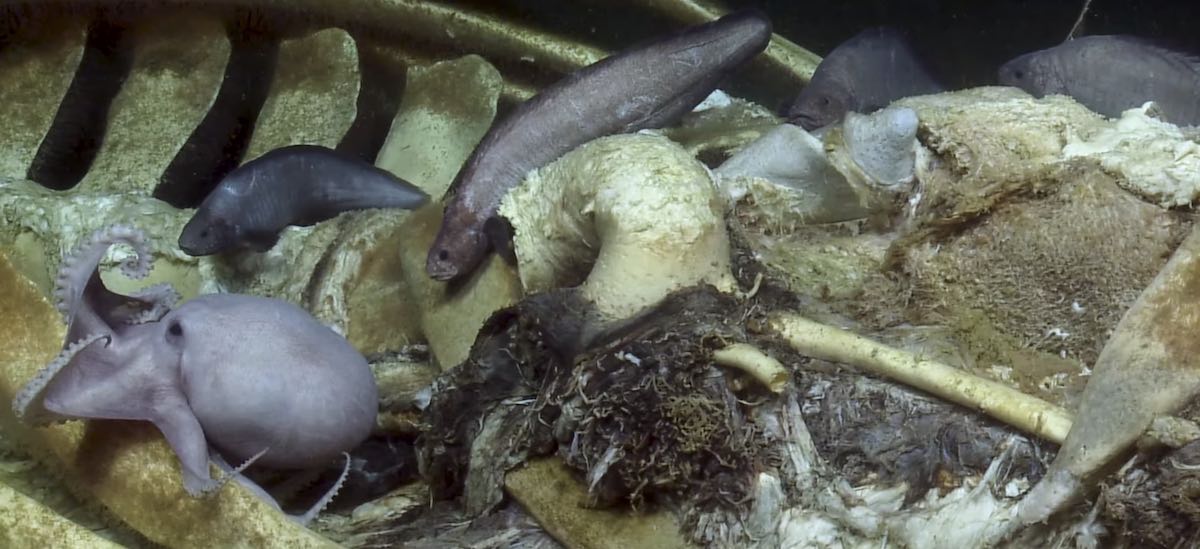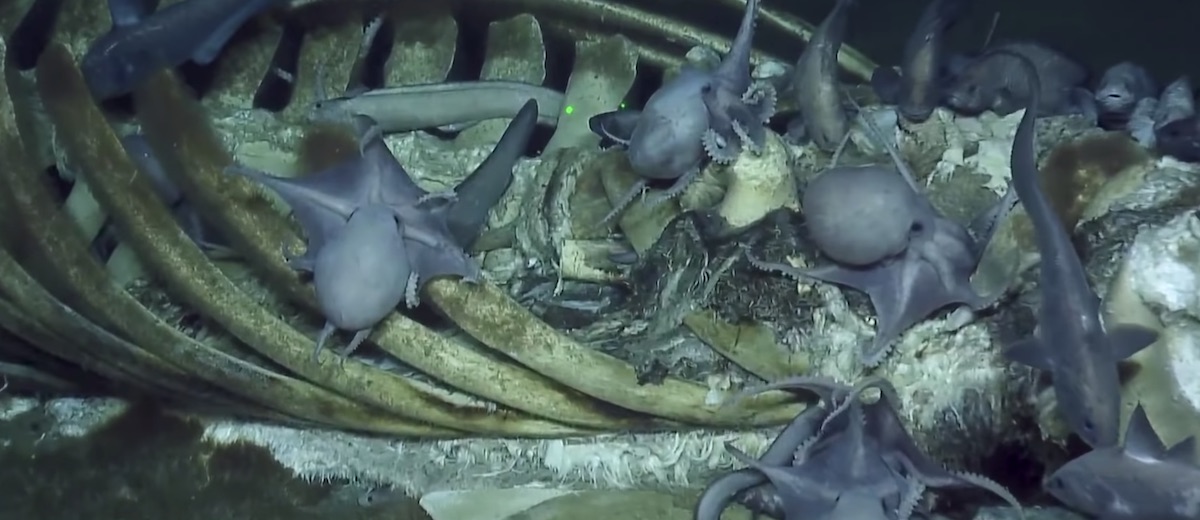Whale Falls are the Hottest Restaurants in the Deep Sea
They have everything: Ghostly fish, cephalopods, bone-eating worms and so much more.

In the dark stretches of the deep sea, food can be hard to come by. So when hundreds of thousands of pounds of food falls from above all at once, it’s a party.
We got to see the feeding bonanza first-hand this week when research vessel E/V Nautilus live-streamed the discovery of a deep-sea whale fall. The carcass was discovered two miles below the surface while exploring Davidson Seamount in Monterey Bay National Marine Sanctuary. Viewers were treated to a close-up view of all kinds of marine creatures eating the decomposing whale (trust us, it’s less gross than it sounds).
In light of the Nautilus’ discovery, we are here to answer all of your deep-sea whale carcass questions. Read on to see why whale falls are a critical part of a healthy ocean ecosystem!
What is a whale fall? Why is it important?
When a whale dies at sea, it sinks (or “falls”) down to the ocean floor. If the animal is in shallow waters with lots of large scavengers, the body is picked apart pretty quickly by sharks, fish, crustaceans and more. But when the dead whale is in deep waters, colder temperatures greatly slow down decomposition rates, allowing the carcass to remain on the ocean floor for months or even years.
Deep sea ecosystems are food limited, meaning many organisms who live there have evolved ways to go without food for long periods of time. Many animals rely on tiny bits of organic matter drifting down from the surface, or “marine snow,” to survive. Marine snow is composed of dead plants and animals, fecal matter, dust and snow, and accumulates on the ocean floor where deep-sea critters scavenge the tiny flakes.
When a whale falls to the ocean floor, it’s like a food oasis in a deep-sea desert, and can support other marine organisms for years. One whale fall can bring the same about of organic material as 1,000 years of marine snow.

Who benefits from whale falls?
The (after)life of a whale consists of three stages: the mobile scavenger stage, enrichment-opportunist stage and the sulfophilic stage. In the mobile scavenger stage, fish like hagfish and sleeper sharks bite the meaty bits off of the carcass. This type of sloppy feeding means lots of small whale pieces end up in the surrounding sediment, attracting even more scavengers. In the enrichment-opportunist stage, crustaceans and worms take advantage of any of the small fragments of tissue left behind. The first and second stages can each last up to two years.
In the final stage, sulfur-producing bacteria break down the bones and any remaining tissue. While the bacteria break down the bones, they support a community of mussels, worms and clams that can live alongside the bacteria. This stage can last for decades until there is nothing left of the whale.
If you watched the live-steam, you saw a number of organisms chowing down on the whale fall (if you haven’t watched it yet, what are you waiting for?). Scientists identified ghostly octopuses, eelpouts (an eel-like fish that lives in the deep sea) and grenadiers (fish with rat-like tails which led to their nickname, rattails). They also saw Osedax worms or polychaete worms who drill into bones and digest the lipids (their name literally means “bone-eating”). If you look at the photos, the worms look like red peach-fuzz covering the bones.
We know whales are part of a healthy, thriving ocean. And thanks to the incredible footage from the Nautilus, we have a better understanding of the important role in the ecosystem whales play after their death. Almost 70,000 whales die every year, mostly from disease or injury, resulting in hundreds of thousands of whale falls around the world at a given time. Think of the millions of marine organisms that are supported by those falls—what would happen to them if whale numbers decreased? It’s up to us to keep the ocean a safe place for whales and the organisms who depend on them.
